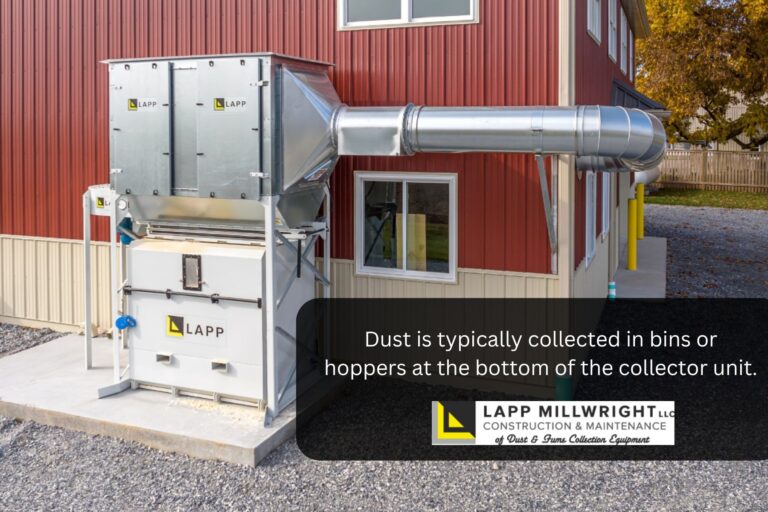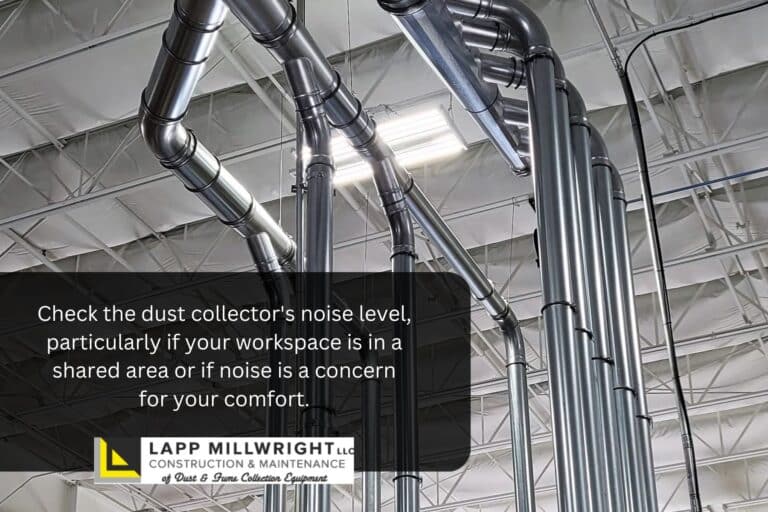Picture this: it’s a warm summer day, and the sun shines brightly through the dust haze in your small manufacturing shop. You’ve been struggling with a cough for a few days, and one of your employees just reported that one of the machines has broken down. When you dig into the problem, you find clogged filters and ducts.
The culprit in all of this – the small but mighty dust speck.
Ok, this might be a worst-case scenario, but it’s possible if you work in an industry that produces dust without proper air filtration.
That’s where dust collection systems come in! At Lapp Millwright, these systems are our specialty. In this blog, we’ll introduce you to economy dust collection systems: the perfect solution for small businesses.
Let’s take a closer look!
Why Are Dust Collection Systems Important?
Dust collection systems are vital for any shop that produces significant amounts of dust and particulate matter. Here are some key reasons why these systems are crucial.
Health and Safety
Respiratory issues are a common concern for those working in dust-prone industries like woodworking shops. Exposure to certain types of airborne dust, such as silica dust or wood dust, can lead to respiratory issues and long-term health problems. At a minimum, irritants like sneezing, coughing, and eye irritation can result, and, at worst, various forms of lung disease can develop. Dust collection systems help minimize dust inhalation, protecting the health and safety of workers.
Fire and Explosion Safety
In certain industries, the accumulation of combustible dust can create a high-risk environment. Dust collection systems help prevent such dust buildup, reducing fire risk and explosions. Industries like woodworking, metalworking, and food processing must manage combustible dust to ensure a safe working environment.
Equipment Performance and Maintenance
Dust and other particulate matter can quickly accumulate on machinery and equipment, decreasing machine efficiency and wear and tear. Regular cleaning is one way to deal with this dust, but the amount required would be very time-consuming and inefficient. On the other hand, dust collection systems remove dust efficiently, which helps maintain equipment performance and reduce wear.

Legal Compliance
Many industries are required to comply with environmental regulations that mandate some level of airborne pollutant control. Dust is considered an airborne pollutant and is regulated under these laws. Dust collection systems help businesses comply with these regulations, avoiding fines, legal consequences, and dangerous, environmentally damaging workplaces.
Product Quality
Maintaining a clean environment is critical for ensuring a quality final product, especially in food processing, pharmaceuticals, and electronics industries. Dust collection systems help prevent product contamination and maintain high standards.
Energy Efficiency
When designed and operated efficiently, dust collection systems contribute to energy conservation. By capturing dust at the source and using energy-efficient filtration methods, these systems can reduce a facility’s overall energy consumption.
Improved Workplace Environment
Dust collection systems contribute to a cleaner and more organized workplace. This enhances the overall working environment for employees and improves visibility, reducing the risk of accidents.
Community Relations
While it’s unlikely a small business would release large amounts of dust into the surrounding environment, it’s still important to consider the potential impact on the local community. Dust collection systems are one way to address environmental concerns and ensure good community relations proactively.
How Do Dust Collection Systems Work?
Dust collection systems capture and remove airborne dust and particulate matter from industrial and commercial environments. The critical components of a typical dust collection system include:
Capture Hood or Ducts
The system begins by capturing dust at the source using hoods, nozzles, or ducts strategically placed near the areas that produce the most dust. This can be near machinery, cutting tools, or other points of dust creation.
Ductwork
Once captured by the hood or ducts, the dust-laden air travels through a network of ducts. These ducts transport from the various collection points to the central dust collector.
Dust Collector Unit
The heart of the dust collection system is the dust collector unit. There are different types of dust collectors, and the choice depends on factors such as the type of dust, the volume of air, and the specific application. Here are a few common types:
- Cyclone Collectors use centrifugal force to separate dust particles from the air stream. These collectors are generally cheaper but may not be as effective.
- Baghouse Collectors use fabric filter bags to capture dust particles with up to 99.9% efficiency.
- Cartridge Collectors use pleated filter cartridges to remove dust particles. These cartridges can be mounted vertically or horizontally.
Filter
Dust-laden air enters the dust collector unit, where the filter media (bags, cartridges, or other filtration materials) captures the dust particles. Clean air exits the collector and is either recirculated into the facility or released outside if it meets environmental regulations.
Dust Disposal
The collected dust accumulates on the filter media. Periodically, the system will need cleaning to remove the accumulated dust. Depending on the type of collector, this can involve methods such as pulse-jet cleaning, reverse air cleaning, or mechanical shaking.
Exhaust Fan
An exhaust fan helps create the necessary airflow through the system. It pulls the contaminated air through the ductwork and into the dust collector, ensuring an efficient collection process.
Monitoring and Control
Dust collection systems often include monitoring and control mechanisms. These can include sensors to measure the dust concentration, pressure differentials across filters, and other parameters. Automated controls adjust the system as needed, optimizing performance and energy efficiency.
Disposal or Recycling
Dust is typically collected in bins or hoppers at the bottom of the collector unit. Depending on its nature, it may be disposed of or, in some cases, recycled.

Now that you’re more familiar with how a dust collector works let’s examine the elements of a great system.
What to Look for in a Great Dust Collection System
A high-quality dust collection system is essential for maintaining a clean and safe working environment. Here are key factors to consider when selecting a dust collection system.
Airflow/CFM (Cubic Feet per Minute)
Adequate airflow is crucial for effective dust collection. Ensure the system’s CFM rating is sufficient for the size of your workspace and the type of dust in your shop.
Dust Collector Type
Collectors can come in single-stage and two-stage variations. Two-stage systems are generally more efficient because they separate larger particles in the first stage. This reduces the load on the finer filter in the second stage.
Filtration Efficiency
Look for a system with high filtration efficiency. HEPA (High-Efficiency Particulate Air) filters are excellent for capturing very fine particles and ensuring cleaner air.
Filter Cleaning Mechanism
Choose a system with an automatic or manual filter cleaning mechanism to prevent clogging and maintain consistent airflow.
Noise Level
Check the dust collector’s noise level, particularly if your workspace is in a shared area or if noise is a concern for your comfort.

Hose Diameter and Length
Ensure the system comes with appropriately sized hoses for your equipment and that the hose length is sufficient to reach all the necessary workstations.
Quality and Durability
Look for a well-built unit made from durable materials like steel. The construction should withstand the demands of your specific applications.
Compliance with Safety Standards
Ensure the dust collection system complies with relevant safety standards (e.g., NFPA compliance) and regulations to maintain a safe working environment.
Ease of Maintenance
A system with easy-to-access components and straightforward maintenance procedures will save time and effort in the long run.
Choosing the Right Size Dust Collection System
Choosing a dust collector that’s the right size for your space and the amount of dust you’re likely to produce is important. Here’s a formula to help you determine what size system you’ll need:
Room’s floor area (sq.ft.) × ceiling height (ft.)× ACH (Air changes per hour)÷60 = airflow (CFM)
Let’s say your shop area is 600 square feet, the ceiling height is 10 feet, and the recommended air change is 5 per hour.
900x10x5/60= 750 CFM
This means you’ll need a system with a minimum of 750 CFM.
How Lapp Millwright Can Help
We hope you found this blog helpful! At Lapp Millwright, we offer high-quality economy dust collection systems perfect for small- to medium-sized shops. Here’s what sets them apart from the competition:
- Great value
- Can be placed indoors or outdoors
- Quiet operation
- Low maintenance and intuitive to operate
- Simple set up
- Anti-static beane filter bags
- Customizable upgrade, including control panel, dump hopper, and shaker.
We also offer
- Industrial Dust Collection Systems
- Woodshop Systems
- Smoke and Fume Collection Systems
- Maintenance and Repairs
- And more!
We’d love to work with you! Reach out today for your free estimate.





